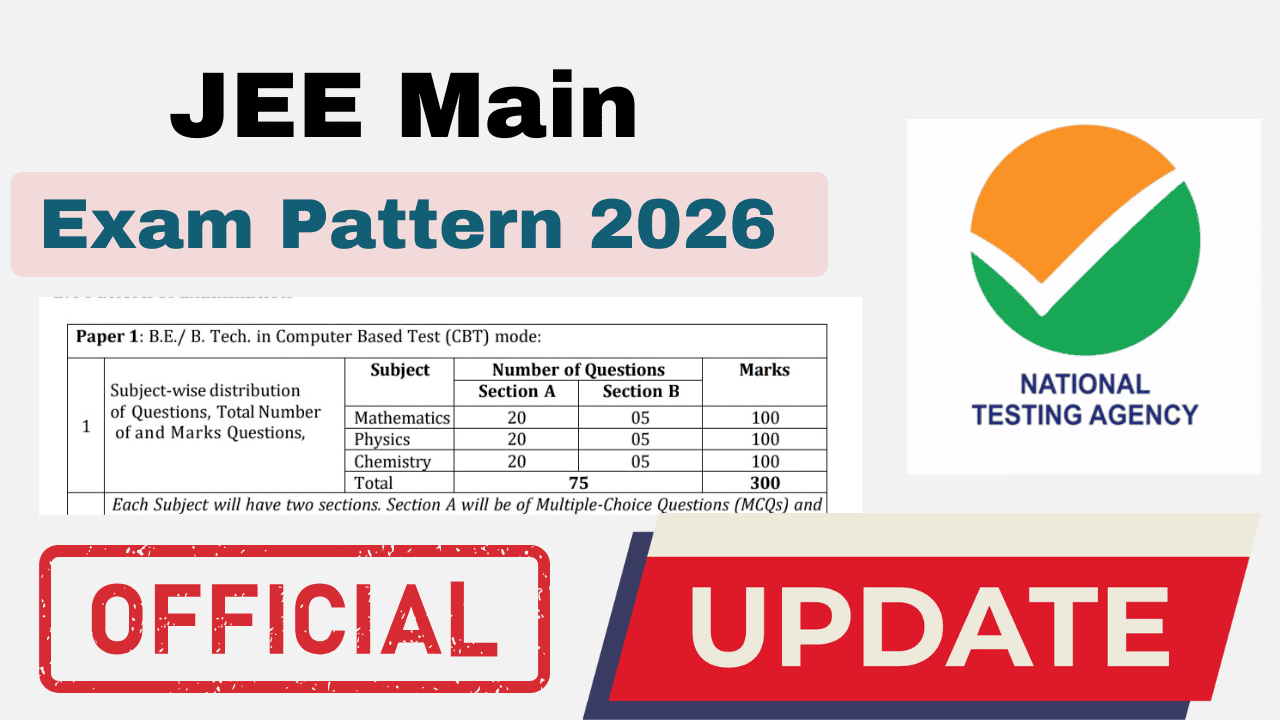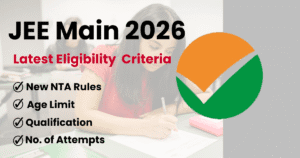If you’re preparing for JEE Main 2026, you probably think you know the exam: Physics, Chemistry, Maths, 3 hours, and negative marks. True, but the way the paper is structured and a few recent clarifications from the National Testing Agency (NTA) mean the exam could still surprise you if you prepare the “old” way.
This guide gives you the updated exam pattern, what changed or caused confusion, and precise, actionable tips to adjust your preparation.
Quick Snapshot — What the JEE Main 2026 Exam Actually is (Short Checklist)
- Paper 1 (B.E./B.Tech): Computer-Based Test (CBT), 3 hours, 75 questions, 300 marks.
- Structure: 3 subjects - Mathematics, Physics, Chemistry. Each subject has 20 MCQs (Section A) + 5 Numerical Value Questions (Section B). Total = 25 per subject × 3 = 75 questions.
- Marking: +4 for correct, −1 for incorrect applies to MCQs and Numerical Value Questions unless the question is dropped. Unanswered = 0.
- Two sessions (Jan & Apr 2026); if you sit both, the best total NTA score (best of two) is used for ranking.
Why JEE Main 2026 Exam Pattern can Surprise You
Numerical Answer Questions are built into every subject (not optional)
Earlier, you could treat the paper as mostly MCQs with occasional short numericals. Now, every subject has a dedicated Section B with 5 numerical-answer questions.
These are not multiple-choice; you must type the numeric answer (often to the nearest integer, when instructed) using the on-screen keypad. That changes how you practice: you cannot rely on option-elimination for these questions.
Negative marking also applies to numerical answers
A common misconception is that numerical-answer-type questions carry no negative marking. For JEE Main 2026, numerical answers also carry −1 for a wrong answer (same +4/−1 scheme). That makes guessing riskier and careful accuracy more valuable.
Confusion over calculators: Don’t bring one
An earlier version of the bulletin mentioned a “virtual calculator” and caused panic and debate. The NTA has issued a clear correction: no calculators are allowed in any form, neither physical nor virtual, for JEE Main.
You will, however, use an on-screen numeric keypad to enter numerical answers. Don’t expect a calculator during the test; train to do arithmetic mentally and with fast, accurate paper work.
Registration Updates You Need to Know
NTA has introduced several registration changes. The Aadhaar auto-fill feature now directly verifies candidate details from your Aadhaar card. The age limit for JEE Main eligibility has been removed, and exam centers have increased to 323 cities (up from 299).
A critical new requirement: You must provide your Class 11 registration number during registration. This mandatory field ensures better verification and helps prevent scheduling conflicts between JEE Main and board exams.
Exact paper layout (for Paper 1 — B.E./B.Tech)
- Mathematics: 20 MCQs (Section A) + 5 Numerical (Section B) - 100 marks.
- Physics: 20 MCQs + 5 Numerical - 100 marks.
- Chemistry: 20 MCQs + 5 Numerical - 100 marks.
- Total: 75 questions, 300 marks, 3 hours. There will be negative marks for incorrect answers in Section A and Section B.
What this Means for Your JEE Main 2026 Strategy
Before Study
- Update yourself with official bulletins and public notices on the NTA/JEE Main website at least once, as they announced session dates and clarifications for 2026.
- Work out a two-session plan: if you can, plan to attempt both sessions as NTA considers the best total score.
Study & Practice (Weekly Habits)
- Split practice: 50% MCQ strategy (speed + elimination) and 50% numerical strategy (exact computation + estimation).
- For numerical questions: practice typed-entry numericals; time yourself, ensure rounding rules are clear (many JEE numericals ask for the nearest integer).
- Mental arithmetic drills: squares, cubes, fractional arithmetic, common trig values, you’ll need these without a calculator.
- Mock tests: use official-style CBT mocks that don’t show calculators. After each mock, classify mistakes into conceptual, computation, and careless; reduce computation errors actively.
In the Exam (Day-of Tips)
- Read instructions for each numerical question carefully: if it asks “round to nearest integer,” do that; otherwise, don’t force rounding.
- Avoid wild guessing: because numerical questions also carry negative marks, only answer when you have reasonable confidence.
- Manage time: 75 questions in 180 minutes ≈ 2.4 minutes per question. Reserve the last 20–30 minutes for verifying numerical answers and calculations.
Small but Important Rules & Admin details
- Mode: Paper 1 is CBT; Paper 2A (B.Arch) includes a drawing test in pen-and-paper mode; Paper 2B (B.Planning) is CBT. Know which paper you applied for.
- Languages: JEE Main 2026 is offered in multiple languages (including English and Hindi, plus regional languages). Check the bulletin for the language mapping to centres.
- Dates & sessions: Session 1 (Jan 2026) and Session 2 (Apr 2026), registration windows were announced in the official notification. Plan the board exam overlaps accordingly.
Relevant Articles:
JEE Main 2026 Latest Notification
JEE Main 2026 Syllabus PDF Download
Updated Eligibility Criteria for JEE Main 2026
Where Will You Take JEE Main 2026? Find Out Here!
Final Takeaways
The JEE Main 2026 exam brings subtle yet crucial changes that every aspirant must note. Each subject now includes a dedicated numerical section with negative marking, making accuracy just as vital as speed.
Since calculators are not allowed, you’ll need to strengthen your mental math and quick problem-solving skills. Practicing typed-entry numerical questions regularly will help you adapt to the on-screen format.
Also, try to attempt both sessions: January and April, as NTA will consider your best score for ranking. In short, understanding these updates and adjusting your strategy early will help you avoid surprises and perform your best on exam day.
Believe in your preparation; consistency and clarity will turn your hard work into results.








